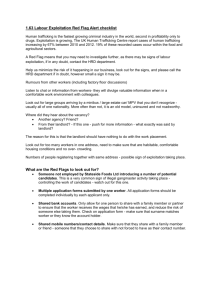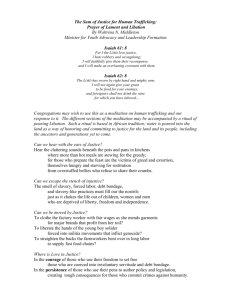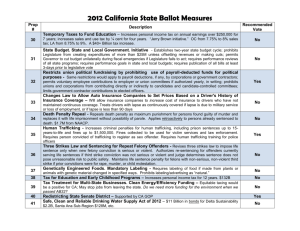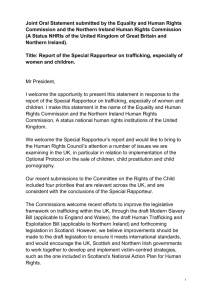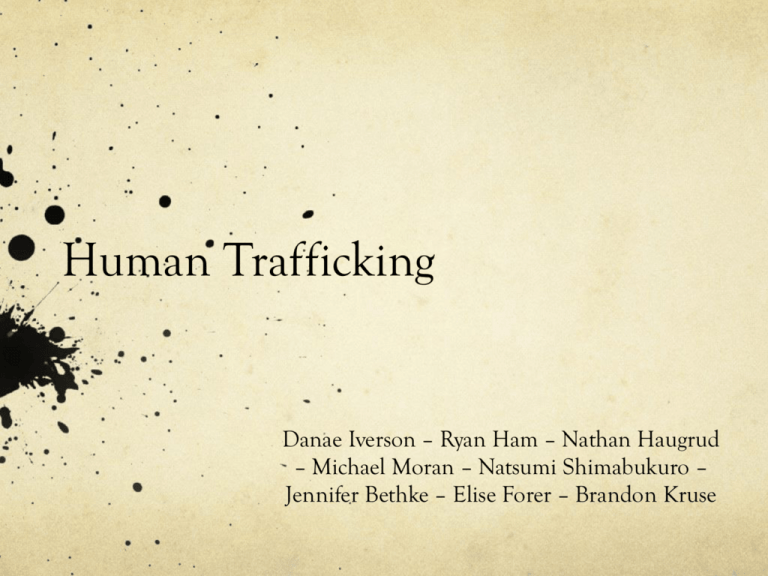
Human Trafficking
Danae Iverson – Ryan Ham – Nathan Haugrud
– Michael Moran – Natsumi Shimabukuro –
Jennifer Bethke – Elise Forer – Brandon Kruse
The Problem
What
UN Definition of Human Trafficking:The
recruitment, transportation, transfer, harboring or
receipt of persons, by means of the threat or use of
force or other forms of coercion, of abduction, of
fraud, of deception, of the abuse of power or of a
position of vulnerability or of the giving or
receiving of payments or benefits to achieve the
consent of a person having control over another
person, for the purpose of exploitation
MM
The Problem
What:(cont’d)
Approximately 50,000 people are trafficked into
the U.S. per year
According to UN estimates, about 2.5 (U.S. State
Department actually estimates between 4 and 27)
million people from 127 countries have been
trafficked to 137 countries for purposes such as
forced labor, sexual exploitation, the removal of
organs and body parts, forced marriages, child
adoption and begging.
NH
The Problem
Who
Who is aversely affected world wide*?
Men 9%
Women 77%
Children 33%
Boys 12%
Girls 48%
Sexual Exploitation 87%
Forced Labor 28%
The sum is over 100 because this is percentages of sources in the Trafficking database that refer to cases involving the
particular feature of human trafficking practice. Sources can refer to more than one victim profile or form of
exploitation
MM
The Problem
Who: (con’t)
Who benefits, or profits from this practice?
Traffickers: According to Interpol, sex trafficking is estimated to generate
$7 billion for initial sale and $19 billion for labor and sex exploitation
world wide annually. Also traffickers often make their victims work off
“debts” (for transporting them) up to $40,000.
Farmers: Up to 50% of the estimated 15,000 people trafficked into the
United States every year is for agricultural, and general labor
exploitation, these are often people who are conned into getting
transportation across the boarder and paying for it later, which ends up
really being slavery
Pimps: Use economical and physical force to exploit women and children
by forcing them to perform sexual acts for money.
Johns: These people purchase the victims for their own sexual use.
Brothel owners: are willing to pay up to 16,000 dollars to buy women,
who are an investment and end up making the owners sometimes many
times more than they were bought for.
MM
The Problem
Where:
Purple:
Country of
Origin
Gray:
Country of
Destination
Red: Both
BK
The Problem
Where (con’t): Human
trafficking is widespread, the
United Nations Office of Drugs
and Crime document the
trafficking of human beings
from 127 countries to be
exploited in 137 countries.
Albania, China, and Lithuania
are all rated very high for the
countries where the country of
origin is from. Whereas,
Germany, Japan, and the
United States are rated very
high for destination countries of
the exploited individuals.
Origin Countries Destination
Countries
Albania
Belgium
Belarus
Germany
Bulgaria
Greece
China
Israel
Lithuania
Italy
Nigeria
Japan
Rep. of Moldova
Netherlands
Romania
Thailand
Thailand
Turkey
Ukraine
USA
BK
The Problem
How:(does it effect individuals?)
When an individual is a victim of human
trafficking it causes them physical and
emotional harm. The transferring and
harboring of an individual results in them
suffering from sexually transmitted diseases,
tuberculosis, and damage to their reproductive
parts. Often times the individual needs
counseling or therapy from the traumatic stress
human trafficking puts them under.
JB
The Problem
How (someone becomes a victim) :
-Trafficked people are usually the most vulnerable and
powerless minorities in a region.
-Most likely are from poorer areas and are often ethnic
minorities.
-Many are displaced persons or refugees.
-There have been victims from every social background,
class or race.
-Children are often sold by parents.
-Many victims are deceived by certain promises, such as
a good job in another country or a false marriage
proposal.
EF
The Problem
When:
Those found to be victims of sex trafficking are youth
between the ages of 9-19, predominately women and
girls.
The average age of entry is 11.
Between 2001-2005 only 140 defendants have been
convicted of human trafficking in U.S. Courts, which
represents a 109% increase from 1996-2000.
EF
The Problem
WHY: The Buyers, Sellers, and Victims
Human trafficking is the fastest growing criminal
industry in the world
Why sellers sell:
-Total Annual Revenue estimated to be around $42.5
billion USD
-Propelled by small specialized outfits, prosecution is
rare.
Why buyers buy:
-Forced labor in the forms of physical labor, sexual
labor, or child labor.
EF
The Ideal State
Ideally, there would be no human trafficking in
the United States, since we realize this is
impossible, drastically reducing the number of
trafficking cases as well as providing services for
those impacted is important to the protection of
our society, families, and youth.
JB
Procedure of Treatment
1.
Creation of more programs and services designed to serve
trafficked victims heal and start a new life.
Find a job/learn self sufficiency skills
Have counseling and support groups
Get enrolled in school
Help them obtain a visa
1.
2.
3.
4.
1.
5.
6.
“ T Visa”
Help contact a relative if possible
Educate foster care parents to successfully care for victims
DI
Procedure of Treatment
2. Education and public awareness
-Develop creative resources
about sex trafficking
-Media and ads
NS
Procedure of Treatment
3. Stricter penalties and consistent, uniform law enforcement.
-the traffickers must not be allowed to use the consent of
the victims as a defense against trafficking.
-it must be more difficult for buyers to purchase women.
-women should be treated as victims, not as criminal illegal
immigrants.
4. Prisons should offer mandatory rehabilitation and
counseling for trafficking offenders while completing their
prison sentence.
NS
Procedure of Treatment
5. More family involvement
- Efforts to increase the value of a human life
- Sex education
- The demand
DI
“Research on men who purchase sex acts has found that many of the
assumptions we make about them are myths. Seldom are the men
lonely or have sexually unsatisfying relationships. In fact, men who
purchase sex acts are more likely to have more sexual partners than
those who do not purchase sex acts. They often report that they are
satisfied with their wives or partners. They say that they are searching
for more – sex acts that their wives will not do or excitement that
comes with the hunt for a woman they can buy for a short time. They
are seeking sex without relationship responsibilities. A significant
number of men say that the sex and interaction with the prostitute
were unrewarding and they did not get what they were seeking; yet
they compulsively repeat the act of buying sex. Researchers conclude that
men are purchasing sex acts to meet emotional needs, not physical needs. Men
who purchase sex acts do not respect women, nor do they want to
respect women. They are seeking control and sex in contexts in which
they are not required to be polite or nice, and where they can
humiliate, degrade, and hurt the woman or child, if they want.”
Theoretical Support
Hughes, Donna M., (2001) The “Natasha” Trade: Transnational
Sex Trafficking. National Institute of Justice Journal.
January 2001, pg.8-15 (In 1998, Sweden passed a law that created a new
offense: “gross violation of a woman’s integrity.” Prostitution was included as a
type of violence against women. The “purchase of sexual services” is prohibited
and is punishable by fines and/or imprisonment up to 6 months. The government
was clear that this new offense marked Sweden’s attitude toward prostitution as an
“undesirable social phenomenon” This law is the first that aims to protect women
from violence by holding men accountable and thereby addressing the demand for
women to be trafficked for prostitution.)
RH
Theoretical Support
United Nations Office on Drugs and Crime, ed.
Trafficking in Persons: Global Patterns. United Nations
Office on Drugs and Crime. United Nations, Apr. 2006.
Web. 19 Apr. 2010.
<http://www.unodc.org/pdf/traffickinginpersons_rep
ort_2006-04.pdf>. Pg.13
(The U.N. suggests that in order to provide for the
physical, psychological, and social recovery of victims,
housing, counseling, medical, psychological, material,
employment, educational, and training opportunities
must be provided for victims.)
BK
Theoretical Support
Dearnley, Ruth, and Steve Chalke. "Human Trafficking: Prevention,
Prosecution, and Protection." UN Chronicle (2010): 52-55. United
Nations Publications. Web. 19 Apr. 2010. <aspe.hhs.gov/hsp/07>
(Dearnley and Chalke suggest that there are ways to prevent human
trafficking throughout the world. People need to be aware of human
trafficking through every policy area. Whether it is improving
education systems, increasing police patrol, or creating programs to
raise awareness, we must use these strategies to prevent the problem.
The United Nations has taken many steps to improve the problem.
Start Freedom, Active Communities against Trafficking (ACT), and
the Chocolate Campaign have all helped the amount of human
trafficking victims decrease.)
JB
Range of Application
Our treatment applies to all those
involved in human trafficking in the U.S.
(victims, traffickers, buyers).
It applies to families, school systems,
educators, and youth.
NH
Unintended Consequences
Demand for younger children might increase due to
education of the risk of AIDS or STDs.
If the law becomes more inclusive of trafficking offenders,
there will be more people doing illegal activity, and fuller
jails.
Citizen backlash towards the raising of taxes to fund the
programs and services for trafficked victims.
Resistance from parents and students towards sex ed
reform?
Do not desire schools to teach children ‘moral’ or
‘personal’ values about sex.
NS
Success or Failure?
Less victims being treated as criminals, and
instead utilizing rehabilitation services.
Education prevents less people from
becoming victims.
Parents and schools become more aware,
knowledgeable, and involved.
Less cases of human trafficking reported.
More sellers and buyers convicted.
RH
Bibliography
John P. Kelly. (2010, April 3). Young, beautiful and slaves :Asian brothel closings raise concerns over the extent of human
trafficking in the sex trade. The Patriot Ledger,3. Retrieved April 22, 2010, from ProQuest Newsstand.
"Human Trafficking Facts." National Coalition Against Domestic Violence. Web. 15 Apr. 2010.
<www.ncadv.org/files/HumanTrafficking.pdf>.
"Sex Trafficking Fact Sheet." Department of Health and Human Services. Web. 15 Apr. 2010.
<www.acf.hhs.gov/trafficking/about/fact_sheet.pdf>.
Janice G., Raymond PhD, Hughes PhD Donna M., and Gomez BA Carol J. "SEX TRAFFICKING OF WOMEN IN THE
UNITED STATES." Coalition Against Trafficking in Women, March 2001. Web. 25 Apr 2010.
Lederer, Laura J., “Human Rights Report on Trafficking of Women and Children: A Country-by-Country Report on a
Contemporary Form of Slavery, The Protection Project, The Paul H. Nitze School of Advanced International Studies, Johns
Hopkins University”. February 2001.
Dolan, Christine. “A Report on the Exploitation of Children Emanating from the Balkan Crises: A Shattered Innocence, The
Millennium Holocaust, International Centre for Missing and Exploited Children". April 2001
Donna M. Hughes Professor & Carlson Endowed Chair in Women’s Studies University of Rhode Island A Call to Action:
Joining the Fight Against Trafficking in Persons U.S. Embassy and the Holy See Pontifical Gregorian University Rome, June 17,
2004
Bortel, Anglea, Mary Ellingen, Mary C. Ellison, Robin Phillips, and Cheryl Thomas. Sex Trafficking Needs Assesment for the State of
Minnesota. Rep. Minneapolis: Advocates for Human Rights, 2008. Print.
Questions?





